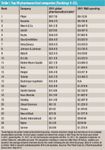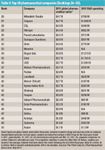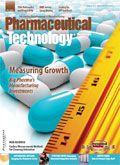Measuring Growth in Big Pharma's Manufacturing Investment
Pharmaceutical Technology's annual manufacturing investment update shows slight gains in biopharmaceutical manufacturing and emerging markets and continued restructuring of supply networks.
Measured growth. That is the best way to sum up the manufacturing investment activity of the pharmaceutical majors during the past year. Companies continue to implement restructuring programs as a way to reduce costs and optimize their manufacturing and supply networks. Investment, when it is made, is primarily in biologic-based manufacturing and emerging markets, with a few select projects proceeding in established product and geographic markets.
Company investment
Pfizer: Pfizer continues with plans to restructure its manufacturing network following its $68-billion acquisition of Wyeth in 2009. Following the acquisition, Pfizer's manufacturing sites totaled 81, and other acquisitions added 20 manufacturing sites. Pfizer subsequently exited nine sites and operated 90 plants as of the end of 2011, with major manufacturing facilities in Belgium, China, Germany, Ireland, Italy, Japan, Philippines, Puerto Rico, Singapore, and the United States. It plans to exit a further 10 sites during the next several years.

BURAZIN/PHOTOGRAPHER’S CHOICE RF/GETTY IMAGES
After the acquisition of Wyeth in 2009, Pfizer operated 20 R&D sites and has restructured its R&D operations, which involved several site closures, including its R&D facility in Sandwich, United Kingdom, except for a small presence there. In 2011, Pfizer rationalized several other R&D sites. It disposed of its toxicology site in Catania, Italy; exited its R&D sites in Aberdeen and Gosport, UK; and disposed of a vacant site in St. Louis, Missouri. Pfizer also shifted its cardiovascular, metabolic and endocrine disease and neuroscience research units from its site in Groton, Connecticut, to Cambridge, Massachusetts, where it signed a lease with the Massachusetts Institute of Technology, with occupancy anticipated in early 2014. In 2011, Pfizer opened Centers for Therapeutic Innovation laboratories in Boston, New York, and South San Francisco.
Novartis. In 2010, Novartis initiated a company-wide program to review its manufacturing footprint, which progressed in 2011, with major goals to create manufacturing centers of excellence, reduce its cost structure, and enhance utilization rates at strategic sites to 80% of capacity. To these ends, the company has announced the exit or partial exit of 14 sites since the program started in 2010. In Liverpool, UK, and Marburg, Germany, Novartis discontinued certain manufacturing activities to consolidate its influenza-vaccine platforms. Novartis also divested the pharmaceuticals division's sites in Casablanca, Morocco, and Huningue, France, and Sandoz (the generic-drug business of Novartis) sites in Jena, Germany, and Buenos Aires, Argentina. The company also discontinued pharmaceuticals manufacturing at sites in Tlalpan, Mexico, and Horsham, UK, and exited CIBA Vision production sites in Cidra, Puerto Rico, and Farnham, UK. Additionally, the company announced the discontinuation of certain manufacturing activities at its CIBA Vision site in Atlanta, Georgia, and the consolidation of pharmaceutical chemical operations in Switzerland, as well as closure of its chemical operations in Torre, Italy.
Novartis continues to make progress in the long-term redevelopment of its St. Johann headquarters site in Basel, Switzerland. This project, called "Campus," started in 2001 with the aim of transforming the site from one of primarily pharmaceutical production into a center of knowledge with a primary emphasis on international corporate functions and research activities. Through Dec. 31, 2011, the total amount paid and committed to be paid on the Campus Project was $2.1 billion. The company expects that through 2015, it will spend more than $2.5 billion and transfer production facilities to other sites in the Basel region.
Novartis continues to expand in emerging markets. In June 2011, Novartis began construction on a new $140-million manufacturing plant for pharmaceuticals and generic drugs in St. Petersburg, Russia. The plant is expected to produce approximately 1.5 billion units per year (oral solid dosage forms). In China, in 2007, Novartis opened a start-up facility for a new R&D center in Shanghai, China, and broke ground in 2008 on Phase 1 of a new facility that was originally to be home to approximately 400 R&D scientists and approximately 400 other pharmaceuticals division personnel. In 2009, it expanded the scope of the site with plans to invest $1 billion during the next five years to increase the size of its operations in Shanghai. Based on a re-evaluation of the site conducted in 2010, the current Phase 1 has been extended by two buildings. The cross-divisional Shanghai campus will house 800 offices and 400 laboratory workplaces.

Table I: Top 50 pharmaceutical companies (Rankings 1â25).
In October 2010, Novartis announced plans to invest $600 million during the next five years to build new laboratory and office space for research activities in Cambridge, Massachusetts. In 2011, the company finalized design plans for the new buildings, received necessary zoning changes from the city of Cambridge, and began preparing the site for construction. In late 2010, Novartis began a construction project on the campus of Novartis in East Hanover, New Jersey, which will continue through 2013. The company expects that through 2013, it will spend more than $545 million to complete the construction and consolidate operations there.

Table II: Top 50 pharmaceutical companies (Rankings 26â50).
In other recent investments, in June 2008, Novartis broke ground on a new $330-million rabies and tick-borne encephalitis manufacturing facility in Marburg, Germany. Construction is complete, and the facility is in the process of executing the necessary validation activities. Regulatory approvals for products are planned for 2012 and 2013. In November 2009, Novartis opened a new cell culture-based influenza vaccine manufacturing site in Holly Springs, North Carolina. As of December 31, 2011, the total amount spent on the project was $463 million, net of grants reimbursed by the US government. The total investment in this new facility is expected to be at least $900 million, partly supported by grants from the US government and prior investments in influenza cell- culture technologies at the Novartis vaccines site in Marburg, Germany. Novartis also began a project for a new $305-million vaccine-manufacturing facility in Recife, Brazil, with technical start-up of the facility planned for 2015. In 2011, Novartis' eye-care business, Alcon, completed the construction of a new $134-million manufacturing and R&D plant in Singapore; the plant is scheduled to produce saleable product after regulatory approval in 2012.
Novartis said it is making progress for resolving quality-control issues at its consumer healthcare operations in Lincoln, Nebraska, and at three facilities of Sandoz. In December 2011, Novartis suspended production at is Lincoln manufacturing site in conjunction with a voluntary recall of all lots of select, bottle-packaged configurations of certain over-the-counter products. In December 2011, FDA cited quality-control issues at three Sandoz manufacturing facilities in Broomfield, Colorado; Wilson, North Carolina; and Boucherville, Canada. In an Apr. 24, 2012, first-quarter earnings release, Novartis said that it is making progress in remediating the quality issues at the Lincoln site and the three Sandoz production sites.
Merck. Merck & Co. continues to move forward with restructuring. In February 2010, subsequent to the Merck and Schering-Plough merger, Merck began a global restructuring program in conjunction with the integration of the two companies. In July 2011, the Merck announced the latest phase of the restructuring program, which included a further reduction of its workforce of 12–13% company worldwide. A majority of the workforce reductions in this phase relate to manufacturing (including animal health), administrative, and headquarters organizations. Previously announced workforce reductions of of 17% in the earlier phases of the program primarily reflected the elimination of positions in sales, administrative and headquarters organizations, as well as from the sale or closure of certain manufacturing and R&D sites and the consolidation of office facilities.
Sanofi. Sanofi's subsidiary Genzyme began production of the enzyme-replacement therapy Fabrazyme (agalsidase beta) at its new facility in Framingham, Massachusetts, following approval of the facility by FDA and EMA in January 2012. In May 2012, EMA and FDA approved a second operation for fill–finish at Genyzme's Waterford, Ireland, manufacturing plant, which nearly doubled capacity for fill–finish for Myozyme and Lumizyme (alglucosidase alfa) at the 4000-L scale. These developments follow a 2010 consent decree issued by FDA to Genzyme for manufacturing violations at its Allston, Massachusetts, facility and resulting requirements to transfer fill–finish production out of that facility. Other investments by Genzyme include expansion of Myozyme production capacity in Geel, Belgium, Fabrazyme in Framingham, Massachusetts, Thymoglobulin (anti-thymocyte globulin (rabbit)) in Lyon, France, and the filling operations in Waterford, Ireland.
Other recent investments by Sanofi are in two new Lantus production lines in Frankfurt, which complemented an earlier acquisition of the Diabel manufacturing site from Pfizer, to expand insulin production. Sanofi invested in its Brindisi, Italy, site to expand production of spiramycin, the API in the antibiotic Rovamcyin. The company also is investing in the launch of epiCard, a gas-powdered single-dose, single-use, auto-injector for epinephrine.
Sanofi is continuing with its Biolaunch project, which is designed to converts its chemical facilities to biotechnology-based production. It is on track to create a monoclonal antibody production facility at its site in Vitry-sur-Seine, France, and is investing in new biosynthetic processes as its sites in Saint-Aubin-Les Elbeuf and Vertaolaye, France. In May 2009, Sanofi began construction of a new EUR 300 million ($364 million) manufacturing center in Neuville-dur Saône, with the the goal to progressively transition existing chemical production to vaccine production beginning in 2013. Sanofi Pasteur, the vaccine arm of Sanofi, is scheduled to begin commercial production of a new antigen production unit in Mexico for seasonal and pandemic influenza vaccines in 2012, once the necessary production and marketing approvals have been obtained from Mexican regulatory authorities.
In emerging markets, in May 2012, Sanofi inaugurated a new assembling and packaging line for producing its prefilled insulin injection pen Lantus SoloStar at its facility in Beijing. The company announced a second phase $90-million project to install a cartridge aseptic product line at the facility. The facility has a designed capacity of 48 million units. Sanofi is building a new manufacturing site in Hangzhou, China, to replace an existing manufacturing site there, which is scheduled to be completed in 2012. The company reached an agreement with the King Abdulah Economic City to build a manufacturing facility for solid-dosage forms in Saudi Arabia.
Roche. In 2011, Roche executed 25 major engineering projects. Key projects included transforming its manufacturing facility for solid dosage forms in Shanghai from a local to a global supply operation. In early 2011, the facility received FDA and EMA approvals to produce Xeloda (capecitabine) for the US and EU markets.
In June 2011, Roche completed a CHF 191-million ($193 million) expansion at it facility in Penzberg, Germany, which upgraded and expanded the site's therapeutic protein development and production capacity. In November 2011, Roche completed construction of a new CHF 250 million ($252 million) technical R&D facility in Basel, Swizterland. The facility houses laboratories, offices, and small-scale production lines. In late 2010, Roche divested technical development and small-molecule manufacturing operations in Boulder, Colorado, to Corden Pharma. Corden will continue to supply Roche with commercial-scale peptides and chemical APIs. Roche also sold its clinical plant in Oceanside, California to Gilead Sciences.
GlaxoSmithKline. In March 2012, SmithKline (GSK) announced plans to invest more than £500 million ($798 million) in the UK across its manufacturing sites, which included selecting Ulverston in Cumbria as the location for the first new GSK manufacturing facility to be built in the UK in almost 40 years. The company also will invest in sites in Montrose and Irvine, Scotland.
GSK's announcement followed plans by the UK government to implement a "patent box" to encourage investment in R&D and related manufacturing in the UK by introducing a lower rate of corporation tax on profits generated from UK-owned intellectual property. Following a feasibility study conducted through 2011, GSK said it will locate a new £350 million ($559 million) biopharmaceutical manufacturing facility in Ulverston, Cumbria. Detailed planning and design of the new facility is underway with an anticipated start date for construction of 2014–2015, dependent on portfolio timing and obtaining necessary planning and related consents. Once construction starts, it is likely to take at least six years before the plant is fully operational.
GSK also reported in March 2012 that it is considering additional manufacturing investment at Ulverston, which could double the total investment at the site to approximately £700 million ($1.1 billion). GSK will invest more than £100 million ($160 million) in its two manufacturing sites in Scotland: an expansion at Montrose for key materials for its respiratory drug and aluminum adjuvants for vaccines and expanded antibiotic production capacity at Irvine. GSK will also invest in sustainable green-energy production and environmentally friendly manufacturing technologies at both sites. The company is making other investments totaling £80 million ($128 million) at its sites in Ware in Hertfordshire to increase manufacturing capacity for its respiratory-inhalation device and at Barnard Castle in County Durham to establish a dermatology-manufacturing center of excellence.
As GSK proceeds with new manufacturing investment, it continues to restructure. In 2011, GSK met its original target of £2.2 billion ($3.4 billion) in annual cost-savings and identified additional annual savings of approximately £600 million ($931 million), bringing expected total annual savings of £2.8 billion ($4.3 billion) by 2014. GSK has cut its pharmaceutical R&D footprint by more than 45% during the past three years from 494,000 m2 to 295,000 m2. During the same period, its manufacturing organization has achieved annual savings of approximately £600 million ($931 million). Since 2006, GSK has exited 19 manufacturing sites, including selling or closing four factories in 2011, thereby reducing its total number of manufacturing sites to 74.
AstraZeneca. In February 2012, AstraZeneca announced new restructuring initiatives aimed at delivering annual cost-savings of $1.6 billion by the end of 2014. The restructuring will reduce headcount by 7300. The job cuts include 1350 positions in supply-chain and manufacturing operations and 2220 positions in R&D, including ending R&D activity at sites in Sodertalje, Sweden, and Montreal.
Overall, AstraZeneca's capital expenditures on supply and manufacturing facilities were approximately $388 million in 2011 (2010: $333 million; 2009: $360 million). At the end of 2011, approximately 9600 people at 23 sites in 16 countries were working on the manufacturing and supply of products. In October 2011, AstraZeneca announced an investment of $200 million to build a manufacturing facility in China Medical City in Taizhou, Jiangsu province, China, to meet growing local demand.
Bristol-Myers Squibb. In May 2012, FDA approved Bristol-Myers Squibb's biologics manufacturing facility in Devens, Massachusetts, for commercial production of the company's arthritis drug Orencia (abatacept). The $750-million multiproduct bulk biologics manufacturing facility in Devens represented the largest capital project in the company's history.

Pharmaceutical Tariffs Are Imminent: How Industry is Bracing for Impact
April 16th 2025On April 14, 2025, the Trump Administration launched a national security-driven investigation into pharmaceuticals, a move that will likely result in tariffs being placed on pharmaceutical drugs, ingredients, and other components that are imported from outside of the United States.
Drug Solutions Podcast: A Closer Look at mRNA in Oncology and Vaccines
April 30th 2024In this episode fo the Drug Solutions Podcast, etherna’s vice-president of Technology and Innovation, Stefaan De Koker, discusses the merits and challenges of using mRNA as the foundation for therapeutics in oncology as well as for vaccines.